Uncategorized
Gynocentrism and the golden uterus (part two)
The following is part 2 of my article on debunking the bedrock of the female supremacist belief system that drives gynocentrism; the golden uterus. Please read part 1 before continuing. – Peter Ryan

The Naturalistic Fallacy
Often reproductive reductionists will appeal to nature to justify their bigoted beliefs that we should treat men as a lower class of human being, or even regard men as subhuman on the basis that having a uterus makes an individual more biological valuable to the species. The assertion that having a uterus makes an individual more biologically valuable is wrong, because it assumes that reproduction is the sole determining factor of biological value – and I have explained in part one of this article why this is wrong.
But I want to assume for the moment that reproductive reductionists and female supremacists are right. Should we value human life on its utility? Should we base society and government policy on the survival of the fittest and selectively abort males prior to birth and subjugate the males that are born, as some female supremacists put forward? We have numerous examples of genocides in the 20th century that were the inevitable end result of such ideas.
We have seen what happens when such a society dehumanises a group of people and the destruction it brings for such societies. We have observed the legacy and the guilt such atrocities have on their culture. History is littered with such examples, and there is a reason why societies that dehumanise groups of people remain either undeveloped tribal shitholes or deteriorate into such shitholes given enough time. It never ends well for the society that dehumanises a group within their population, let alone the half of the population responsible for keeping most of the infrastructure going, etc.
If we are concerned about making sure civilisation remains functional enough so that it can sustain itself, then we should consider the reality that dehumanising half the population which keeps the water running and the lights on at night, will invariably lead to its collapse. When enough men are that marginalised they have nothing left to lose, history shows it leads to revolution and war. That is just me citing history, it is not a threat. The United States itself was founded in the wake of marginalised men fighting a tyrannical government. If national security matters to our governments, then they might want to consider what happens when large numbers of men are raised with no father for generations, have little or no employment prospects and are marginalised in society.
For the record, I do not want to see a violent revolution happen. I want to peacefully go about my business. However I am concerned about the growing likelihood of this eventuality occurring, and the steps we should be taking right now to reduce the risk of future national instability in Western countries from large numbers of marginalised men. The solution is not to marginalise men further. The solution is simply to respect men, invest in them, support them, and guide and provide them with an avenue to voluntarily contribute to society in a way that is personally fulfilling and constructive.
Treating men as subhuman, creating a male underclass and demonising and marginalising men and boys on the basis they are male, is a sure-fire way to bankrupt your country, collapse your economy, socially destabilise your society and destroy your country from within through civil unrest, crime, revolution and war. If you treat men and boys with no compassion, then do not be surprised when you create monsters and witness a surge in mass shootings, organised crime, roaming gangs of male thugs and eventually an organised militia and then an army. I do not want to see that future unfold, but that is where society is headed if we don’t start treating men as human beings and supporting them.
So on a purely rational level, appealing to nature to subjugate and marginalise men is not sustainable or functional for the long-term prosperity and the continued existence of civilisation. The Nuremburg trials that were organised after World War 2 are a testament to that reality in the aftermath of the atrocities committed by the Nazis against the Jews.
In the words of Justice Jackson1,
The privilege of opening the first trial in history for crimes against the peace of the world imposes a grave responsibility. The wrongs which we seek to condemn and punish have been so calculated, so malignant, and so devastating, that civilization cannot tolerate their being ignored, because it cannot survive their being repeated. That four great nations, flushed with victory and stung with injury stay the hand of vengeance and voluntarily submit their captive enemies to the judgment of the law is one of the most significant tributes that Power has ever paid to Reason.”
A statement that needs to be etched in stone. When we dehumanise men or any group of people, we undermine the basis of civilisation itself- human dignity. We do not just undermine the dignity of the group that is dehumanised, but our own dignity by participating in the abuse or letting it happen. Once dignity is gone, civilised behaviour quickly goes as well and with it civilisation.
Some people infer from history and from the present day, that dehumanising men and treating them as disposable is natural, normal and okay, as they believe it is required for civilisation. Slave owners used to use similar arguments to justify slavery. Disposability implies that something can be discarded without any consequence and that it can easily be replaced. Civilisations and tribal communities have certainly required a contribution of protection, provision and innovation from men to ensure their continuation. However just as with reproduction and evolutionary success, male contribution to the community is not automatically interchangeable with male disposability. Men can contribute to communities without being disposed of and the less that are lost, the more men are available to contribute in the future.
Any community or civilisation that loses its men or fails to invest in its men, or fails to adequately support them, loses some or all of its manpower and some or all of the contribution men bring to sustaining civilisation and their communities. The loss of male life and the marginalisation of men is something to be minimised and avoided, because it costs communities and it costs civilisation. Any community that exploits and marginalises men and neglects them, squanders and wastes the value men can provide to society. By avoidably undermining the well-being and health of men, communities and civilisations undermine themselves.
Any community that exploits and marginalises men and neglects them, squanders and wastes the value men can provide to society. |
It is indeed the case that men have sacrificed their lives in war for their countries countless times, but that does not mean it was ideal for that society that they lost their men. The loss of male life in war was just unavoidable, just as women dying performing their reproductive role in childbirth was unavoidable for centuries. The country that not only won battles but did so with the least amount of male casualties, had the larger army to win the war and the men available to rebuild their societies and occupy and rebuild the societies of the territory they captured.
As with women in childbirth, men have died in performing their role for society. Society has days to recognise the cost of the sacrifice of millions of men in war. Anzac Day, Memorial Day and Remembrance Day come to mind. Disposable utilities do not have days of remembrance. We say, “Lest we forget” on Anzac Day for a reason. Deep down we recognise the loss that society, countless families and the men themselves incurred, from losing men in war. We have days of remembrance in part to remind ourselves of the cost of war and the cost of losing men. It is a solemn warning not to forget the cost of war.
Countries that raised their men and boys properly and invested in them and supported them, had more available men that were equipped to power their economy and participate in a larger and fitter military in times of war. Strong support for men and boys creates strong men and strong men create strong empires. The empires that not only harness the potential of their men, but look after their men and lose as little of their men as possible, prevail and win. These are not an either/or set of priorities for a given civilisation, one priority is dependent on the other.
The simple truth is that civilisations that look after men so they can in turn look after society, prosper and they eventually surpass civilisations that exploit their men and treat them as disposable. Yes societies require men to contribute to their continued existence and prosperity, but with the least amount of loss to male life and well-being. Societies that follow that simple rule thrive over societies that do not.
I am not suggesting that we have never had elements of society and our culture over history and in the present day, that have marginalised men, exploited men and treated men as disposable. We certainly have. The difference between the past and the present though, is that in the past we recognised to a certain extent the need to minimise needless male sacrifice as much as possible, despite the far greater incidence of male sacrifice. The sacrifice of men was not ideal for past society, it was just often unavoidable. Unavoidable male sacrifice is not the same as regarding men as disposable. One perspective recognises the value in men and the other does not. Over the last 250 years and particularly over the last 50 years, this perspective has been lost.
In the present prosperous, safe, well nourished and risk free society we live in, we take men for granted. We have normalised men’s marginalisation and exploitation and confused unavoidable male sacrifice in the past as a justification to treat men today as disposable. Society can get away with this temporarily until the safety bubble of prosperity bursts, from its own decadent recklessness and disregard for the men keeping society running.
Current Western society does indeed marginalise men and has increasingly treated men as disposable, as the costs of male sacrifice for society have faded into distant memory since World War 2. However the West does so to its own detriment and eventually given enough time neglecting the men it relies on to sustain itself, will result in the collapse2 of the West as other societies take its place.
Male disposability proliferating and becoming normalised, is a characteristic of the final stages of a decadent and complacent civilisation on the decline. It is a pathology arising from societal decadence. Some collective pathological behaviour will always be present in a society, regardless as to what stage it is at. However it is in the final stages of civilisation, that pathological behaviours previously minimised and confined to the margins of society, start to spread and become normalised. This is the same pattern that has occurred with male disposability.
In the last 1000 years, male disposability and gynocentrism has slowly grown century after century from the fringes of our culture, to a substantive and enduring level. Much of the proliferation of male disposability within our culture, has occurred in the last 250 years and especially in the last 50 years. We have always had some degree of male disposability in the past, just as we have always had murder and rape. That does not mean we considered it to be normal or acceptable to the point it was pervasive within every aspect of the entire culture, like we see today.
Like I said earlier, regarding men as disposable and society accepting the unavoidable level of male sacrifice required to protect and sustain society, is not the same thing. One perspective recognises the value of male life and the other perspective does not. The difference in the current cultural climate is that now we are rationalising and justifying male disposability, and gynocentric double standards in an effort for our society to convince itself it is “normal”, when it is anything but normal.
There are plenty of behaviours that have natural and biological underpinnings that are not optimal for society and are morally repugnant. Rape, murder and infanticide are seen in the wild and in other primate species and are driven in part by hormones, genes and biology. A man that rapes a woman or a young underage girl who is fertile, enhances his reproductive fitness. That does not make it okay to rape them. Plenty of violent, pathological and deviant behaviours have a biological basis to them and improve reproductive fitness. None of these acts are morally right and normalising them on the basis they are natural will not allow a civilisation to prosper and sustain itself over long periods of time. In fact normalising such behaviour is a recipe to turn civilisation into an uncivilised barbaric primitive tribal shithole.
If female supremacists want to argue treating men as disposable and as subhuman is acceptable and right because it is natural, then they should have no problem accepting that rape is acceptable and morally right because it is natural. Both of course are not acceptable or right. If female supremacists are going to rationalise double standards against men on biological grounds, we can argue the same when it comes to race and the biological differences between races. Again both forms of bigotry of course are wrong. However if female supremacists want to remain logically consistent, then they should at least have the honesty to acknowledge they are no different from the KKK and numerous other groups that claim group supremacy and appeal to nature to justify their beliefs. Claims of male supremacy or any other form of group supremacy on the basis of biology, are not morally justifiable either.
Acknowledging biological group differences does not automatically require making value judgements about the value of human life and justifying double standards based on the group an individual belongs to. Advanced society requires an advanced culture that acknowledges biological differences between individuals and groups, but rises above appealing to nature to justify bigoted and irrational beliefs and double standards that are demonstrably dysfunctional and that undermine the long term prosperity, stability and sustainability of civilisation. Societies that invest in men and support men will have the manpower to flourish, and societies that exploit men and marginalise men will not. That is just a fact. Whilst male sacrifice has been unavoidable at times, it came at a great cost to society. Those societies that minimised such sacrifice had enough healthy men available to live and fight another day and they prospered.
I do not think I need to describe the value men provide to civilisation in detail. Men discover, invent, design, build, maintain, repair and improve the bulk of basically every facet of our infrastructure, technology and buildings. Men are responsible for the majority of the leadership, innovation, research and expansion of the intellectual frontiers of civilisation and our political, legal and economic systems. Our military, police and emergency services all heavily rely on men. Men are the bulk of our Nobel laureates, Fields Medallists and inventors. None of this has changed despite 50-60 years of feminist social engineering and affirmative action. Whether or not feminists want to accept it, there are biological underpinnings to these realities and the value men provide to their families, their communities and their civilisation.
If men stopped working for a week, billions would be dead from thirst, starvation and violence before men went back to work, as a result of the lack of basic working utilities and mass unrestrained civil unrest. Men are not easy to replace either. It takes 18 years of parental and societal investment to raise an adult male from scratch and they must be raised properly so they have the required physical health, mental health, skills, knowledge and motivation, in order to productively contribute to society.
This is why our current society is screwed. Even if we started today reforming the education system, marriage, family courts and divorce, the legal system, health system and workplace etc, to attend to the social, medical, psychological, learning and employment needs of men and boys and ensure fathers play a role in raising children, it is going to take at least a generation to see any positive impact on society. This idea we can just disregard men and boys with no consequences to society and treat them as disposable, is an idea that will be unlearned through suffering and death on a scale society has not seen for centuries. Death and suffering on a scale that matches our own collective stupidity and reckless indifference toward male well-being.
Our best hope to stave off this social and economic catastrophe is to take as much redemptive action as quickly as possible, to reduce the long-term consequences of this multidecade indifference toward men and boys, and use the now unavoidable consequences coming our way as a lesson for future generations on what not to do. We need to value men, boys and masculinity again in our culture and we need to do it now.
Society requires men, because men like women have an intrinsic value that society depends on to survive and thrive. An intrinsic value that arises from the unique male biological potential they possess. If society harnesses this male potential and does not squander it by exploiting and marginalising men, society persists and advances. Just as women have the potential to bear children, men have the potential to provide, innovate and protect. If we are going to argue men are human doings because they only have value from what they produce, then why not argue women are human doings that only have value if they produce children? Of course I am not endorsing this, but I want to make a point here.
If we are going to argue men are human doings because they only have value from what they produce, then why not argue women are human doings that only have value if they produce children? |
Using the bigoted logic of a reproductive reductionist, women’s reproductive utility has no value if women remain barren (as growing numbers of them are). That question and that logic provokes, or at least should provoke scepticism regarding the saying, “men are human doings and women are human beings”. If reproductive utility is the basis of the value of human life, then women themselves only have value based on the quantity of children they produce and those that remain barren are of no value at all. This is not my belief, this is just the logical conclusion that one arrives at by employing the reasoning of female supremacists and reproductive reductionists.
Human males and human females must be treated as human beings if they are to contribute anything to society. Like women, men are not machines. Men have personalities, emotions, hopes and dreams. Men and boys have to be raised properly, invested in, supported, nurtured and loved, to express their potential and do so in a constructive way. Dr. Warren Farrell’s book3 on the boy crisis has some good direction that. If the humanity of men is given no consideration, then their psychological and physical condition will reflect that neglect and their contribution to society will be significantly reduced or eliminated entirely. That is the flaw in treating men like they are human doings.
In some cases with abuse and neglect, male biological potential will not be reduced or eliminated, but instead be directed toward highly destructive and violent ends. If you abuse men and boys and neglect their suffering, then do not be surprised if some of them start shooting people and engaging in violent crime. That is not a justification for their actions, they are still responsible for their actions. However society is also partially responsible for such tragedies through our collective indifference toward the well-being of men and boys.
At the very least if we neglect male well-being, we get failure to launch (which is really nowhere to land), men checking out of society and an epidemic of male suicide. We all know what eventually happens if you fail to look after the general maintenance of your car. If we do not look after the basic needs of men and their general well-being and instead exploit them, then like a car that is not properly looked after, men will break down psychologically and physically. The male suicide epidemic, the falling employment and educational attainment of men, the plummeting fertility rate, the dissolution of the family and the slow and gradual social and economic implosion of Western society, is all partly the result of or entirely because we treat men as disposable and have neglected their humanity.
Exploiting men has a use by date for society, which it will either need to abandon or unlearn through unprecedented death and suffering of its own making. Failing that, natural selection itself will remove gynocentrism and male disposability from humanity, as populations that harness male potential but remember to invest and support their men, surpass populations that do not and replace them. I am not supporting social darwinism, I am just stating reality. Treating men as disposable has consequences.
Civilised society requires us to base the value human life on something beyond its simple biological utility. I am not being hyperbolic when I equate female supremacists with Nazis, because they both make the same fundamental mistake of equating the value of human life with its utility and biological characteristics. The mentally and physically disabled were exterminated with the Jews, because they were deemed by the Nazis to be biologically defective. Claiming men are biologically less valuable than women and using that to justify bigotry, leads to the gynocentric double standards we see today, and eventually given enough time it will escalate to the same outcomes as what occurred in Nazi Germany.
Gynocentrism is indefensible and just based on a different flavour of the same general bigoted logic of every other form of group supremacy in history. Like I said earlier in this article, we have numerous examples in the 20th century alone of what eventually happens to such societies and how it culminates in their decline as other countries prosper and often ends in their collapse. When you put half your population down to benefit the other half of the population, they both sink together.
Humans Are Not Mice or Microbes
As I mentioned in part one of this article, every species has a strategy to maximise its own evolutionary success by strategically investing in activities related to not just reproduction, but survival, growth and parental care (etc.) to differing degrees over their lifespan. Life history theory explains this in detail4. The species whose life history strategies prioritise reproduction, have fast life history speeds. They exhibit little parental investment, reach sexual maturity quickly and have short lifespans and put minimal investment in their own development and growth. They tend toward reproducing once (semelparity) and produce large numbers of offspring. They have relatively high mortality rates among their young and for the population in general, compared to other species with slower life history speeds. Bacteria, and many insects and small mammals like mice and rats, prioritise reproduction.
Complex lifeforms like elephants and humans have life history strategies that show a more balanced investment in survival in addition to reproduction and have slower life history speeds. They have high parental investment, mature slowly, have long lifespans and show substantial investment in their own development and growth. They tend to reproduce multiple times (iteroparity) and produce fewer numbers of offspring. They have lower mortality rates among their young and for the population in general, relative to species with fast life history speeds.
Human beings have high levels of parental investment, long intensive developmental periods and slow rates of maturation. Humans have long life spans, are iteroparous and produce relatively few offspring. We are not a species that focuses on maximising reproduction. Humans perform very poorly relative to other species when comparing rates of reproduction. Humans have a life history strategy that invests considerably in activities other than reproduction, such as survival, parental investment and development and growth. Human communities and human individuals are driven to optimise their own life history strategy, not to just simply maximise their rate of reproduction. Simply focusing on reproduction alone or overemphasising reproduction in a species like humans, leads to evolutionary failure and not evolutionary success. We are not simple microbes, insects or mice that can just rely on breeding our way to the future.
Human beings are social animals that have developed a large brain and a sophisticated culture, precisely because we are so heavily invested in activities beyond reproduction. Many of these activities are focused on maximising our own survival in often unforgiving and harsh environments that demand a more sophisticated life history strategy than simply maximising reproduction. Just pumping out babies does not cut it for humans. That is why we have civilisation and have landed on the Moon. None of that happens if the priority is reproduction and maximising the quantity of offspring. Such a life history strategy does not allow for the developmental period or the somatic effort to be long enough and great enough for a large brain to develop and make such feats possible. If our lineage evolved on the basis of maximising reproduction, we would resemble small mammals with large litters of offspring. There is a reason why mice, insects and microbes are not building rockets to go to Mars. When a species is on the track to maximise reproduction, there is little time or energy for anything else other than reproduction, aside from doing the bare minimum to subsist.
I have experience in the molecular life sciences and a general understanding of evolutionary biology. Yes I am aware of Bateman’s principle, the Trivers-Willard hypothesis etc. None of these evolutionary concepts state women are biologically more valuable than men, or that reproduction alone is the sole determining factor of evolutionary success. That is a twisted inference of evolutionary theory to justify an agenda. It is not science, it is dogma masquerading as science.
Conclusion
What I have described in this article could be mostly arrived at by employing common sense (which is worryingly becoming not so common), that is how simple and basic this is. I find it telling that our culture is so gynocentric that many people are blind to such obvious realities. I find it concerning that even some scientists who should know better, will actually beat a drum claiming female superiority5 because it fashionable to do so in this man-hating culture and I can cite more than one example of this. This is no better than scientists who claimed male superiority in the past and female supremacists make the same error in basing the value of human life on its utility. They cherry pick data and omit facts that do not support their narrative and make unsubstantiated and oversimplified inferences from the data, as this article discusses6.
Make no mistake, there are people with a vested interest in framing human evolution along gynocentric lines to justify their own bigotry. It is simply a matter of time before feminism switches from ignoring sex differences, to acknowledging sex differences and then twisting the science to justify their own female supremacist agenda. The manosphere needs to identify this, be prepared for the switch in strategy from feminists and be ready to address it head on when it surfaces.
It is simply a matter of time before feminism switches from ignoring sex differences, to acknowledging sex differences. |
What I have described in this two part article is just the beginning of debunking the underserved worship of the golden uterus. This is just the opening salvo, there is much more to come. In closing I have provided a link7 from evolutionary biologists Dr. Bret Weinstein and Dr. Heather Heying, on why it is neither “better” to be a man or a woman from an evolutionary perspective and why neither sex is more “valuable”. I will have more to say regarding this excellent video discussing Fishers principle8 and other important evolutionary factors at a later date. For now I encourage people to watch it and am glad to see that at least some of academia has not yet been polluted with female supremacist man-hatred.
Men and women are simply two reproductive components in one reproductive system which the genome fabricates to perpetuate itself. The propagation of a lineage has nothing to do with sexual superiority and everything to do with optimising the interdependent relationship between the sexes that best propagates the genome, given the prevailing environmental conditions. Arguing female superiority in the context of genome propagation is like arguing in the superiority of your reproductive system over your circulatory system. It is a meaningless false dichotomy. It is time for society to see the forest through the trees when it comes to men and women. We are all part of a system bigger than ourselves. Astronauts call this awareness the overview effect9. It is time for humanity to grow up and move beyond these reductionist perspectives of sexual, racial and group superiority and narrow concepts of value and instead look at the big picture.
I note Dr. Robert Sapolsky from Stanford University shares a similar perspective to my own on the dangers of employing reductionist “categorical thinking”, when examining human behavioural biology and I would encourage people to watch his first lecture10 discussing that very danger (in a brilliant highly recommended lecture series on human behaviour). As he discusses, plenty of monstrous activities have occurred on the basis of bad, bigotry driven science. Female supremacists in the sciences twisting the data to push their narrative, are not an exception.
Men and women might be different, but that does not mean society shouldn’t treat men and women with equal dignity (that does not mean equality of outcome). The equal value of human life of all people regardless of race or sex, must be considered sacrosanct for civilisation to remain civil and not descend into tribalism.
References:
- Wikiquote: Robert H. Jackson
- The Fempocalypse!!
- The Boy Crisis: Why Our Boys Are Struggling and What We Can Do About It
- Life History Theory
- The Natural Superiority of Women
- Review of Melvin Konner, Women After All: Sex, Evolution, and the End of Male Supremacy
- Sex: An Evolutionary Perspective | Bret Weinstein & Heather Heying
- Fisher’s principle
- The Overview Effect
- Introduction to Human Behavioral Biology
Gynocentrism and the golden uterus (part one)
By Peter Ryan

The Pedestalisation Of Female Fertility:
The value of masculinity to society and to the species is rarely acknowledged in our modern gynocentric culture. Masculinity is frequently portrayed as toxic and destructive and in need of reform or removal. At the same time, we are told that women are pure and “create life”. Associating the creation of life as something that is exclusive to women and worshipping motherhood, is a gynocentric delusion. There is no recognition in this delusion, of the fact that female uteri remain barren and useless without male sperm. There is no recognition either of the importance of fatherhood in raising children into healthy, productive and well-adjusted adults, despite the plethora of research demonstrating this reality. Women do not create life, men and women create life. The fact that has to even be said, demonstrates how warped human thought can become from gynocentrism.
This culture has an embedded belief that women are superior and men are inferior. Everything wrong in the world is masculine and everything good in the world is feminine. Gynocentrism is based on a belief system in female superiority and so it becomes essential to debunk this belief system if gynocentrism is to be overcome. This article will be the first in one of a number of articles, that will focus on debunking the core foundational premise of female superiority. The foundation of this belief system in female superiority, is that the value of human life is primarily or exclusively based on its reproductive utility. Women have a uterus, women invest more in reproduction, women are the rate limiting factor of reproduction, so therefore women are biologically more valuable than men.
This is the core foundation of the belief structure in female superiority. Does this sound familiar? It should. Even in the manosphere this line of reasoning is promoted by some as an unquestioned truth and the moment you make any step to challenge this belief, you are labelled a denier of biology. In reality, the real deniers of biology are those that deliberately ignore areas of biology that do not fit their gynocentric narrative that the golden uterus is all that counts. These are the reproductive reductionists.
I knew even when I was writing my article “The Normalisation of Gynocentrism”1, and before it was even published, that there would be one specific area of that article that would trigger the reproductive reductionists and that was when I wrote about reductionism. They came out of the woodwork like clockwork as I predicted they would. I know their own arguments and the underlying biology better than they do, from my own experience in molecular genetics and general understanding of evolutionary biology and also most importantly because I have actually listened to what they have had to say for the last ten years. Their arguments have essentially become a form of unquestioned dogma and it is not just a problem I observed in the wider gynocentric culture, but also within the manosphere itself.
Their entire argument rests on an assumption that successful reproduction and evolutionary success are interchangeable. It is important to define terms to avoid confusion. Evolutionary success is the number of copies of the genome of a lineage left behind after a specific period of time has elapsed. If we take a set time period of two centuries for example, an unbroken cyclical chain of investment in survival, development, reproduction and parental investment must take place for copies of the genome of a lineage to be preserved after that passage of time.
Evolutionary success is far more complicated than just asserting that it all comes down to reproduction. Reproduction is merely one step in the cyclical and unbroken chain of events that must successfully take place to perpetuate the genome over time. Reproduction is certainly essential, but so are a multitude of other activities which must occur to ensure preservation of the genome of a lineage. Reproduction itself is often dependent on those activities successfully occurring as well. For example, an organism must survive to mate and reproduce, as it cannot find a mate and then reproduce when it is dead. This sounds obvious and yet some people will persist in maintaining reproduction is all that matters.
Before I debunk reproductive reductionism further, I want to discuss the groups of people I have noticed subscribe to reproductive reductionism. Reproductive reductionists come in three general flavours from my observation, some of which can overlap:
- Female supremacists who believe women are superior and that gynocentric double standards are justified on the basis they reflect the natural order (as they see it). Biology essentially becomes a way of rationalising their own bigotry and persuading others to accept gynocentrism as something normal and good for society. Female supremacists operate on a naturalistic fallacy that what is natural is proper, right and just, and what is natural ought to be good for society.
- Fatalists who subscribe to the view gynocentrism is an immutable aspect of biology based on women being the rate limiting factor of reproduction. They dogmatically refute any argument to the contrary, or that anything can be done to reduce gynocentrism. Fatalists like to live in a world that is certain and where they can excuse themselves and others from taking responsibility for their actions. They generally like to ridicule those that dare to challenge the status quo as being delusional and not realists.
- Ideologues who support a worldview of absolute biological determinism and that anyone who disagrees with them is deluded or irrational. These individuals often hold themselves out as authority figures on evolutionary psychology and biology, often with little or no formal education in the subject. They cultivate an image of intellectual superiority over others who do not support their worldview. They exhibit a naïve realism bias, that objective reality fits their worldview and so people that disagree with their worldview must be deluded, irrational or biased. There is generally a high level of narcissism, combativeness and a lack of humility exhibited by such individuals when challenged.
All three groups are generally impervious to reason, facts and evidence that runs contrary to their assertion that how many uteri you have in a community is primarily what counts to the continued existence of that community. Disagreement with this article does not automatically assign you to one of these groups. Wilfully ignoring facts, evidence and reason that does not support your worldview does.
All three groups make the error in reducing evolutionary success to reproductive success. There are individuals who do not want men to realise their own value, because if they did the powerbase that women rely on to control men would be challenged. As I mentioned in my article “The Gynocentric Mob And Female Superiority”2, the gynocentric social power of women is based on cultivating an image of female superiority. Women only have power in society to the degree that men value what they have to say and what they do. The moment men question female superiority and in particular the moral superiority of women, suddenly women can be held accountable for their own behaviour.
The overvaluing of the female reproductive role and the pedestalisation of the “golden uterus”, is central to female superiority because the female reproductive function is not only essential to the continuation of society, but distinctly female. Challenging the importance of the “golden uterus” in our gynocentric culture is tantamount to questioning the existence of God in fundamentalist communities. You get the same reaction questioning the “golden uterus”, as questioning the basis of a religion. Even some people in the manosphere refuse to question the overvaluing of the female reproductive function, often through omission and ignoring the subject. They will discuss its importance, but never critique its overvaluing in the culture.
Questioning the basis of the gynocentric religion that women are divine beings or more biologically valuable by virtue of having a uterus, is exactly what I am going to do in this series of articles. Functioning as an incubator for nine months does not make someone a mother any more than depositing sperm makes someone a father. Having a uterus does not make you a more valuable human being and like men, women’s value as human beings biologically and otherwise, is not solely dependent on their reproductive functions either.
Maintaining the social fixation on sex and reproduction is key to maintaining female social power that is beyond reproach. In other words, glorifying the female role in reproduction is central to maintaining a belief in female superiority in society and by extension maintaining gynocentrism. Despite what some people in the manosphere think, feminism does not argue that men and women are the same. Feminism argues that women are superior. If men are better at something, then feminists argue this must be due to socialisation and the oppressive patriarchy. If women are better at something, then feminists argue it must be an innate female advantage. If men excel in STEM relative to women, then it is because women are being discriminated against. If girls are excelling in school relative to boys, then it is because girls are smarter than boys. If you want a clear example that feminists do not regard men and women as identical, look at their response to transgenderism and allowing transgender women into female spaces. Feminism is about female supremacy, not gender equality.
What Reproductive Reductionists Miss
So why are reproductive reductionists wrong? I could literally write a book on why they are wrong and I will be going into further and further detail in future articles. However at some point people need to think for themselves and critically evaluate facts by themselves instead of relying on other people’s argumentation. Beliefs like female superiority flourish in societies where people have lost the ability to think and critically evaluate information by themselves. People in such societies essentially become sponges that absorb whatever sets of ideas they find most emotionally appealing and useful pawns to manipulate to further an agenda.
There are three main flaws in the thinking of reproductive reductionists: 1. An ignorance of basic life history theory and that evolutionary success is reliant on a number of activities other than reproduction. 2. A lack of recognition and understanding of biological systems and systems in general. 3. Falling victim to the naturalistic fallacy.
The Optimisation Problem Of Life
Evolutionary success requires a whole sequence of activities to occur in optimum proportion and reproduction is just one of them. Life history theory3 describes the strategic investment that organisms make in their own survival, development, growth, reproduction and in the parental care of offspring over their lifespan to optimise evolutionary success. Maximising evolutionary success in a given environment is an optimisation problem that requires the strategic investment of resources by an organism in numerous activities over their lifespan and reproduction is merely one of them. These often involve trade-offs between investing in activities with limited resources available. For example, a species can invest in maximising the quantity of offspring produced over the quality of offspring they produce, but both cannot be maximised at the same time.
Of course the common retort is that survival leads to nowhere without reproduction. Yes reproduction is essential, but it is not the only essential activity required to propagate the genome. These same reductionists seem completely unaware that reproduction does not happen without survival. An organism or a population has to survive long enough to reproduce and even that alone is not enough. An organism must reproduce an optimal number of times and then raise the offspring to sexual maturity, whom also have to then survive, mate and then raise their offspring. If this does not occur to a sufficient degree then any reproduction that does occur is insufficient to perpetuate the lineage and it dies out.
Simply pumping out babies is not sufficient to ensure the lineage is preserved. Offspring that do not survive to sexual maturity or do not reproduce, are evolutionary dead ends. Organisms that do not invest in their own survival do not reproduce at all, or do not live long enough to reproduce a number of offspring sufficient to guarantee continuation of their lineage (as some of their offspring will die or fail to produce offspring themselves). Parents who do not provide sufficient parental care to their offspring fail to become grandparents because their children either die before adulthood or are in an underdeveloped condition where they are either infertile, cannot carry a child to term, or are unable to attract a mate. Consequently their lineage terminates despite producing children and there is evolutionary failure.
The role that men play in contributing to the perpetuation of their lineage is not just simply based on their contribution to reproduction either. Men make an enormous contribution to the survival of their families and their wider community and that does impact the evolutionary success of their lineage and the community they reside in. The reality is that just as women contribute a disproportionate amount of investment in reproduction, men contribute a disproportionate amount of investment in the survival of their partner, progeny and their community. This investment in survival does contribute to the evolutionary success of the lineage, by allowing more offspring to survive, by enhancing the physical and mental health and development of offspring, by better equipping offspring materially and intellectually for adulthood and by allowing more reproduction to occur etc.
This contribution to survival has been partly what men have been sexually selected for. Men have been shaped by female mate choice to carry the part of the load of perpetuating the species that women cannot, whilst women are temporarily disabled or partly limited by pregnancy and preoccupied with caring for infants and toddlers. Males in our species even directly invest in the raising of their offspring as fathers because of the cost of childhood and juvenile development in our species, unlike males from some of our primate relatives.
The selective advantage of a larger brain and the extension of our developmental period to allow for that larger brain, had a ratchet effect on our evolution. It put long term selective pressures in place that drove mate choice and sexual selection to select for traits and re-task existing traits in men and in women, that enabled a complementary division of labour to emerge. This complementary division of labour and the paternal investment of fatherhood in offspring, played substantial roles in providing the necessary support for the longer and far more costly developmental period of offspring.
The underlying evolutionary processes and the sex differences behind what I have described in the last two paragraphs is discussed in evolutionary psychologist Dr. David Geary’s brilliant book, “Male, Female: The Evolution of Human Sex Differences, Second Edition”4. I am not suggesting that the traditional division of labour as we know it today is biological, I am saying it has biological underpinnings. These biological underpinnings are reflected in the sex differences in interests that feminists refuse to acknowledge5, because it does not suit their underlying agenda of female supremacy.
These sex differences in interests, traits and biological roles, do not make either sex superior to the other. Each sex is an interdependent component in a system that the genome encodes to perpetuate itself. That is the evolutionary context through which these differences emerged and that is the context through which we should be interpreting these differences. It has nothing to do with superiority or supremacy and everything to do with a dynamic adaptive system optimising the propagation of the genome that encoded it over time and across environments, by developing complementary components with complementary strengths and roles, that functionally serve a purpose greater than either component on their own.
Before modern technology and birth control, some gendered division of labour in one form or another was more or less an inevitability of historic and prehistoric populations. Oh and if female supremacists want to argue technology makes men obsolete, they might want to reflect on precisely which sex overwhelmingly develops, maintains and runs the technology first and then reflect on the reality that technology can replace all female functions and jobs, including gestation, and that the dignity of men and women is worth more than just their utility, but I digress. Men have had their space and role in the community and women had theirs. Even indigenous tribes of today have some segregation between the sexes and sites, customs and roles for men and sites, customs and roles for women. They might not have the same gendered traditions and social norms as in the West, but they have them nonetheless.
The fact technology and birth control which men have overwhelmingly been responsible for, has given each sex the personal freedom to expand beyond their past roles, does not negate the reality that biological sex differences remain. It does not negate the reality that there are going to be sex differences in interests and in the roles men and women undertake in society, when we consider males and females as a whole and look at the averages, regardless as to how much feminist social engineering is undertaken. It is not sexism, or entirely cultural, there are biological underpinnings to the differences in the roles males and females adopt in society. The mistake reproductive reductionists make, is ignoring the value of roles outside of the female reproductive function when it comes to their contribution to evolutionary success, or deliberately ignoring or downplaying innate male advantages that contribute to evolutionary success, usually by claiming they are the result of sexism rather than the result of a true male strength.
What I have just described is a very basic overview of biology that reproductive reductionists wilfully ignore or downplay, because it does not conform to their narrative in female superiority, or their narrow and fatalistic worldview. The real deniers of biology are the reproductive reductionists that cherry pick facts that suit their narrative and ignore the multitude of biological facts that don’t.
Systems
Biology is comprised of systems. Your cells are compromised of numerous molecular and subcellular systems. Your body is compromised of numerous systems- the nervous system, the reproductive system, the circulatory system etc. Numerous species live in ecosystems. Reproductive reductionists are incapable of acknowledging the complexity and interdependent nature of human biology. They are incapable of recognising gene culture coevolution and that biology and culture feedback on each other in a continuous loop. They will recognise that biology restricts and shapes culture (which I agree it does), but will ignore the facts and the evidence6 that culture itself introduces novel environments, alters selection pressures on genes and shapes biology. They will recognise that culture is a function of biology, but fail to acknowledge the influence of the environment and that biology expresses itself differently across different environments and timescales.
The human reproductive system requires other body systems to function properly. If the circulatory system fails, or the nervous system fails and the body dies, the reproductive system will fail and die with it. This is an example illustrating the interdependent nature of biological systems that reductionists fail to appreciate. The same interdependence can be observed with ecosystems. Just like the reproductive system in the human body is dependent on the proper functioning of other bodily systems, so is the successful reproduction of a population dependent on numerous other activities aside from reproduction, that are related to the survival, nourishment and growth of that population. Systems thinking is the kryptonite of reductionist thinking, because it forces people to think outside of the categories and the walls they throw up around their own thinking.
A common example that is used by reproductive reductionists is the argument that a tribe decimated by some calamity with a handful of men remaining and the majority remaining being women, will fare better than a tribe with the sex ratios reversed. The argument being that one man can fertilise the uteri of dozens of women and that as there are more women, there are more uteri and thus more offspring can be produced to replace the population in the immediate aftermath. The implied assumption to this scenario, is that all of the women in a tribe (or most of them) will be making full use of their uterus and maximising their reproductive output in the immediate aftermath.
There is no consideration given though for the food, water, resources, protection from predators and shelter that the community and these offspring will require to survive and develop and who will provide those necessities and protect the community, whilst substantial numbers of or all the women in the community are pregnant and/or caring for young helpless infants and toddlers and consequently less able to contribute to these activities.
There is no consideration given to the environmental conditions the population faces and the stresses they impose and the impact a loss of men would have on the community surviving in those conditions. There is no consideration given to the loss of genetic diversity in losing most of the men in a tribe and the impact that increased inbreeding and the subsequent accumulation of deleterious mutations will have on the fitness and fertility of future offspring. There is no consideration given as to whether the environment has the carrying capacity or the community has the adults to provide the shelter, protection and resources, to support such an intensive reproductive effort in the immediate aftermath and all of the offspring and the women raising and giving birth to them.
There is no consideration given to the possibility that a population that produces fewer but healthier, better developed, better equipped and more fertile offspring, with higher parental and alloparental investment and a lower mortality rate, might actually be a more efficient and effective investment of resources in certain environments and have greater evolutionary success, than a population that produces large numbers of offspring with few men around to provide and protect for the community.
Yes there is a minimum number of uteri required to sustain a community, but there is also a minimum level of investment in survival required to sustain a community and a minimum number of males required to achieve that investment through provision and protection and also produce sufficient numbers of offspring with an adequate level of genetic diversity. The minimum thresholds of investment in reproduction, survival and genetic diversity required to sustain a community, will vary across environmental conditions and habitat carrying capacities and the minimum number of males and females required to achieve those thresholds will also vary. In some environmental conditions, more males may be required than females to meet those minimum thresholds. A harsh geoclimatic environment for example may have completely different requirements to a lush jungle with an abundant food supply.
Little thought is given as to how the relative value of the contribution of males and females to sustaining a community may shift, once a community is above the minimum numbers of males and females required to sustain itself and how the relative value of those contributions may vary as a result of population size, environmental conditions and carrying capacity. A population with uteri above the minimum number required to sustain itself, may actually suffer more from losing men than women in certain contexts (provided the number of women lost does not drop below the minimum threshold required to sustain the community).
Little consideration is given to this duality in sustaining a community by reproductive reductionists. I can go on further with a list of omissions reproductive reductionists make when they use this scenario of a decimated tribe, however it should be relatively obvious by now that things are not as simple as they make them out to be. The point that I am trying to make is that human communities are systems and like any system it has components that are interdependent. Reproduction itself is not just dependent on how many uteri you have. The value in producing offspring is only realised if those offspring survive and reproduce viable and fertile offspring themselves. A tribe can produce as many infants as it wants, but if they all die from starvation, predation or a harsh winter before reaching sexual maturity, the tribe is gone.
The male contribution to providing the food, water, resources, habitation and protection to sustain a community, whilst a number of women are temporarily disabled or limited from pregnancy and preoccupied with caring for young infants and children, has a value to the community. This is particularly the case in harsh, hazardous and resource scarce geoclimatic environments, with high levels of predation, brutal winters and summers, rugged terrain and a heavy reliance on physical labour to hunt food, find water, get resources, defend against predators and build shelter. Such environments require high levels of parental investment, which means someone must devote most of their time to directly caring for the young. They also require high levels of investment in survival and high degrees of physical exertion, risk taking, exposure to hazards and a heavy reliance on spatial ability, tool marking and hunting. Simply breeding in such environments is a recipe for death and evolutionary failure.
The ecology of human communities is extraordinarily complex and cannot simply just be reduced down to how many uteri you have. The somewhat amusing thing about this scenario that a tribe with the greatest number of uteri is automatically better off, is that you can put the comments of someone in the MGTOW or MRA community promoting this, right next to the comments of a female supremacist and you would not be able to tell the difference. All radical feminists have to do is point to the same reductive arguments some MRA’s and MGTOWs are putting forward to justify the righteousness and inevitably of their own gynocentric double standards to marginalise men. How long do you think you will be going your own way, before female supremacists use your own reasoning to justify your own subjugation? Just something for certain individuals (but certainly not all) in the manosphere to think about.
Let me finish off part one of this article by pointing to the reality that pedestalising women and pandering to female narcissism reduces your fertility rate. Women are naturally hypergamous and marginalising men to elevate women reduces your fertility rate. This is something both Stardusk and Paul Elam and Peter Wright have both discussed in videos linked here7 and here8, for the “reproduction enthusiasts”. The reality is that even if we just focus on reproductive success alone, treating women as superior and giving them undeserved respect for simply having a uterus and marginalising men, undermines the reproductive success of a community.
The remaining failings of reproductive reductionists will be discussed in part 2 of this article.
References:
- The Normalisation Of Gynocentrism
- The gynocentric mob and female superiority
- Life History Theory
- Male, Female: The Evolution of Human Sex Differences
- Direct evidence that feminists HATE facts
- CARTA: Culture-Gene Interactions: Peter Richerson-Culture-led Gene-culture Coevolution
- Chasing the Dragon
- The So Called Demographic Winter The Hypergamy Factor
Men’s Rights and Women’s Wrongs (1871)
Source: Hackney and Kingsland Gazette – Wednesday 12 July 1871


Mention of ‘gynocentrism’ in a New Zealand newspaper from the year 1907
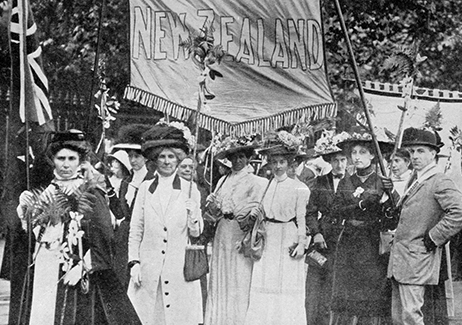
The following article mentions a popular theory of gynocentrism (created by Lester Ward) circulating at the start of the twentieth century. Feminists of the time believed, and still believe, that gynocentrism should serve as the dominant social order.- PW.
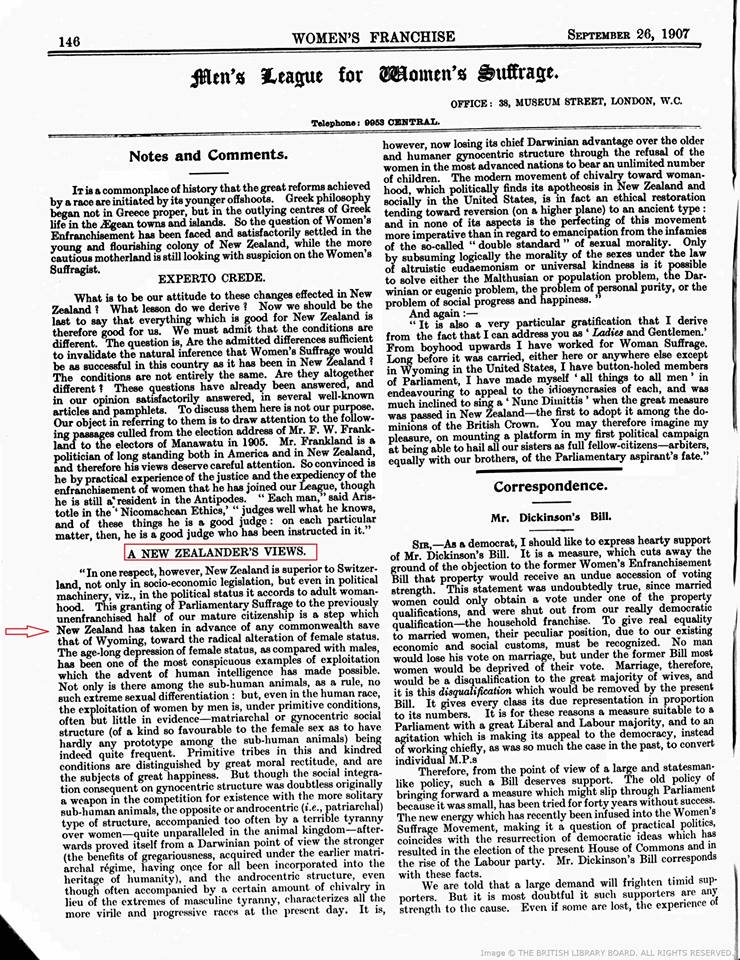
“Anti-man” women’s movements – forerunners of feminist movement (1830 – 1923)
The following are a few clippings from newspaper archives pointing to the existence of an “Anti-Man Movement” – so called by the women who formed them – existing as early as 1830. Clearly ‘anti-man’ turned out to be a branding problem which would later be changed to ‘suffragettes/feminists.’ – PW
___________________________________
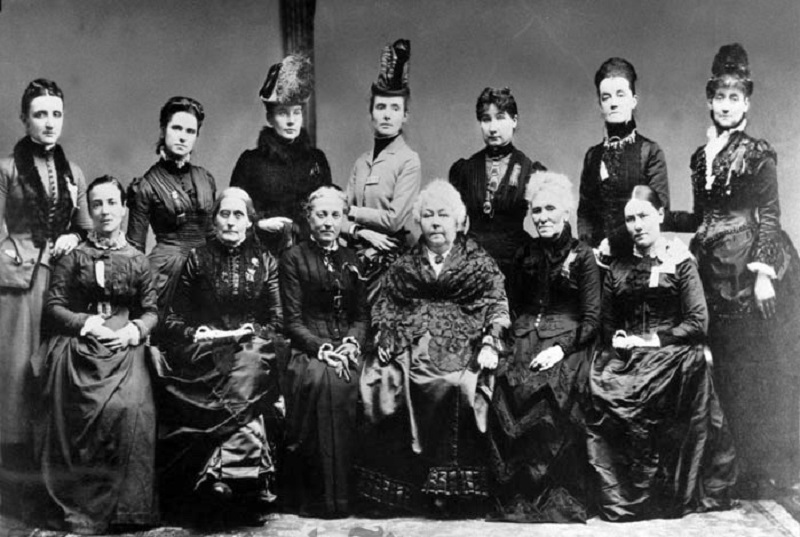
Anti-Man Society.
A meeting of the ladies in Maine has lately been held, to take into consideration the propriety of establishing a society to be called the Anti-man Society. It is said be an established fact that for the last century the male party have, by unholy combination, contrived keep all political offices to themselves, to the exclusion women. They are now resolved to put down this unrighteous combination, and if not exclude men entirely at least to have equal share among themselves.— Philadelphia Paper.

Source: Reported in Northampton Mercury – Saturday 19 June 1830
_______________________________________________
This next one from 1842 mentions the ‘Anti-Man Society’ briefly in the second paragraph:
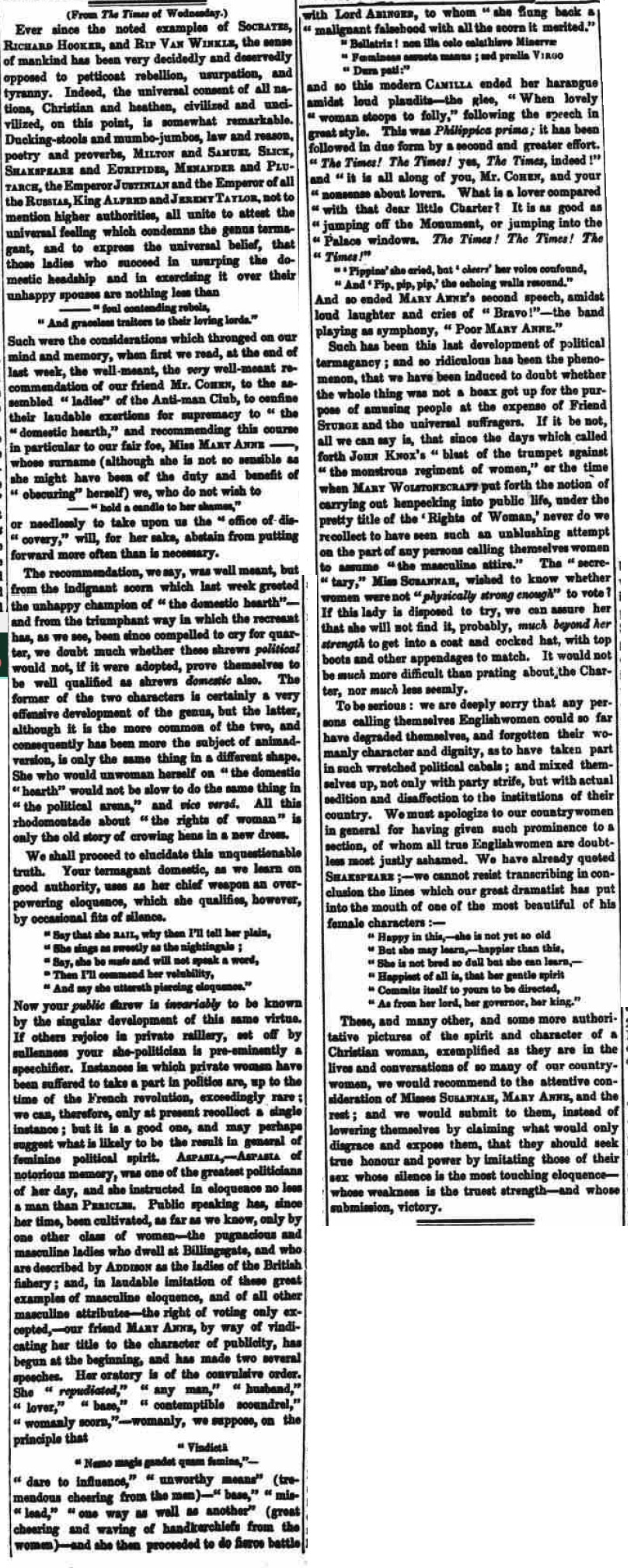
Source: Evening Mail Wednesday 26 October 1842
_________________________________________________________________
The next item details an Anti-Man movement in the year 1895:
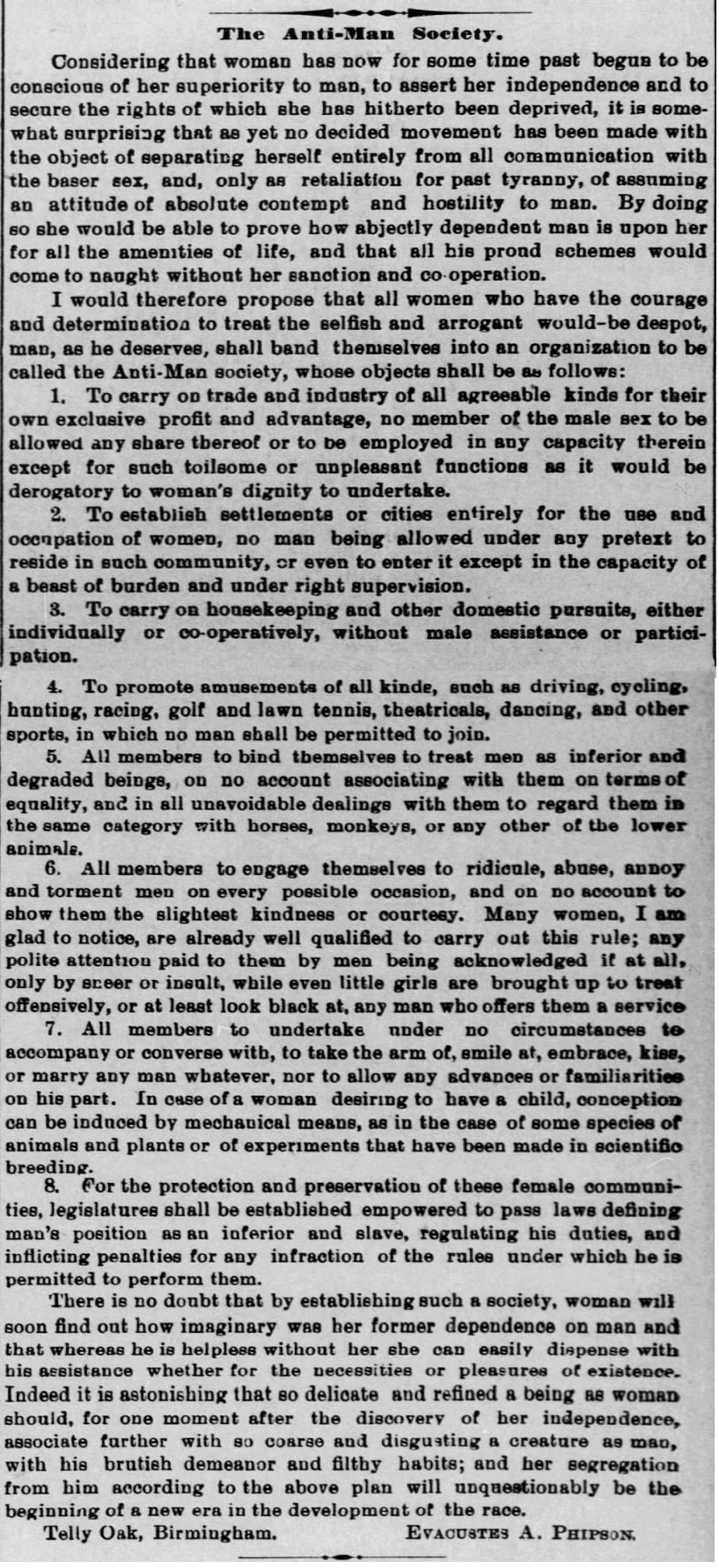
SOURCE: Lucifer the Light-Bearer, 23 Aug 1895, Fri, Page 3
_____________________________________________
This last one is more recent, and I’m not sure what if any relation it has with the original 1830 Anti-Man Society:
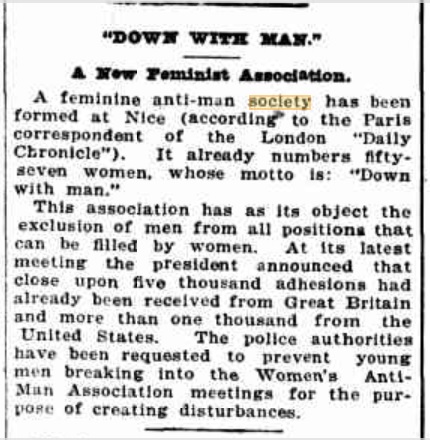
Source: The Cumberland Argus and Fruitgrowers Advocate Newspaper, Wed 13 Jun 1923
Damseling and ‘Chivalry’ in International Negotiations: A Survey Experiment in the Council of the European Union
Daniel Naurin, Elin Naurin, Amy Alexander (2019)

ABSTRACT:
Gender stereotypes—stylized expectations of individuals’ traits and capabilities based on their gender—may affect the behavior of diplomats and the processes of international negotiations. In a survey experiment in the Council of the European Union, we find that female representatives behaving stereotypically weak and vulnerable may trigger a chivalry reaction among male representatives, increasing the likelihood that the men will agree to support a bargaining proposal from the women.
The effect is conditional on the negotiators’ cultural background—the chivalry reaction is displayed mainly by diplomats from countries with relatively low levels of gender equality. Our study contributes to the research on nonstandard behavior in international relations, and in particular the expression and reception of emotions in diplomacy.
We argue that gender stereotypes may have a moderating impact on decision making based on such intuitive cognitive processes. We also add to the broader negotiation literature, both by showing the pervasiveness of gender stereotyping, and by testing at the elite level the generalizability of claims regarding gender effects derived from laboratory experiments. Overall, our findings demonstrate the importance of bringing gender into the study of international negotiations, where it has been largely and surprisingly ignored.
‘Frau Minne’ the Goddess who steals men’s hearts: a pictorial excursion
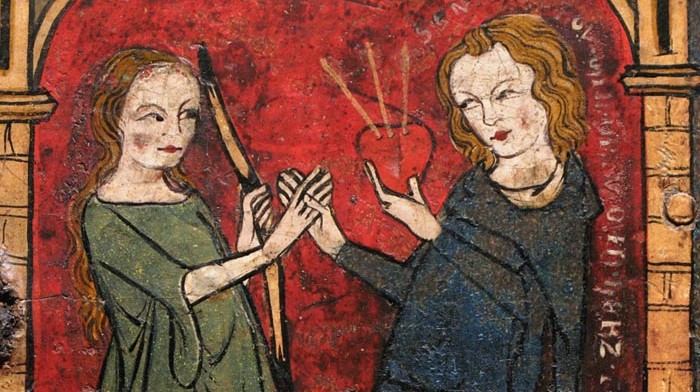
Above is a painting of Frau Minne from Southern Germany, 1320-1330 ca. The image depicts the male lover presenting Frau Minne with his heart which has been pierced by three arrows. There are two German inscriptions with the image, the first of which translates as “Lady, send me solace, my heart has been wounded,” while the second reads as “Gracious Lady, I have surrendered.”
Frau Minne (vrouw minne) is the personification of courtly love from German Middle Ages. She is frequently addressed directly in Minnesang poetry, usually by a pining lover who is complaining about his state of spiritual suffering.
She is often referred to as the “Goddess” of romantic love, which is differentiated strongly from other kinds of love such as Christian agape as embodied in the figure of Jesus. To make the distinction clear, romantic love is understood as passion, whereas Christian and Buddhist love is understood as compassion.
A rare allegorical painting of ca. 1400 (see figure 1), discovered in a guild house in Zurich in 2009 shows Frau Minne presiding over the suffering of male lovers who are having their hearts torn from their breasts. In this cruel scene Goddess Minne, the mistress of love, sits on a throne consisting of two men. She has just torn out the heart of a man to her left which she holds in her hand, while she is already cutting open the chest of another man to her right to rip his heart out.1
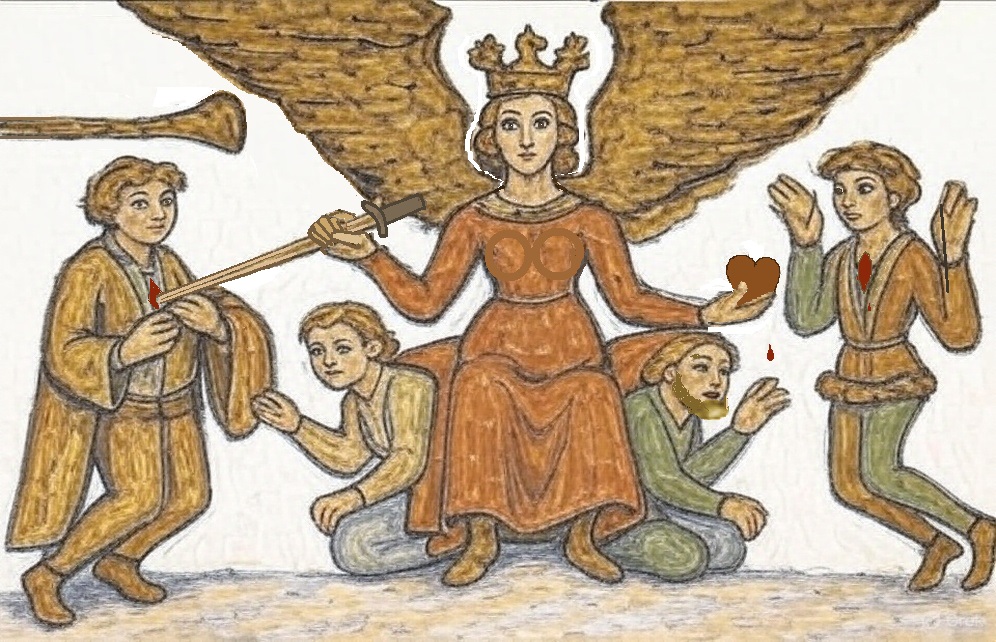
Goddess Minne sits on a throne made of two men, while preceding to rip out the hearts of men in love.
Romantic love involves the deployment of superstimuli, including titillating courtship rituals such as male chivalry toward fetishized ladies that in many ways resembles the power dynamic of sado-masochistic practices. Nevertheless, this still forms the basis of a spiritual practice, and the originators of this religion stated that if you were not suffering, you were not experiencing the fullness of the goddess’s divine power. Such passion-inducing love contrasts with other kinds of love as mentioned above, such as friendship love, parental love extended to children, or that of Christianity or Buddhism which focuses on human compassion.
In Figure 2. (below) N. R. Kline states, “The central section depicts Frau Minne as she presides over a couple that seeks her advice. The bearded lover is presumably the author of the text telling of his plight at having to leave. He points to his chest, with text leading from his mouth that reads: ‘st hat dahin’ (you have my heart [in your hand]). The woman to whom he speaks holds the heart to which the man presumably refers. After a series of entreaties his lady finally gives him her blessing and, in the course of the conversation from one panel to the next, the lady offers her fidelity and the man promises the same. On the cover, winged and crowned, Minne, as both judge and witness, sits on a subjugated crouching man as her throne, a visual metonym of triumphant female power. There are no symbols of the religious trappings of betrothal and marriage.”2
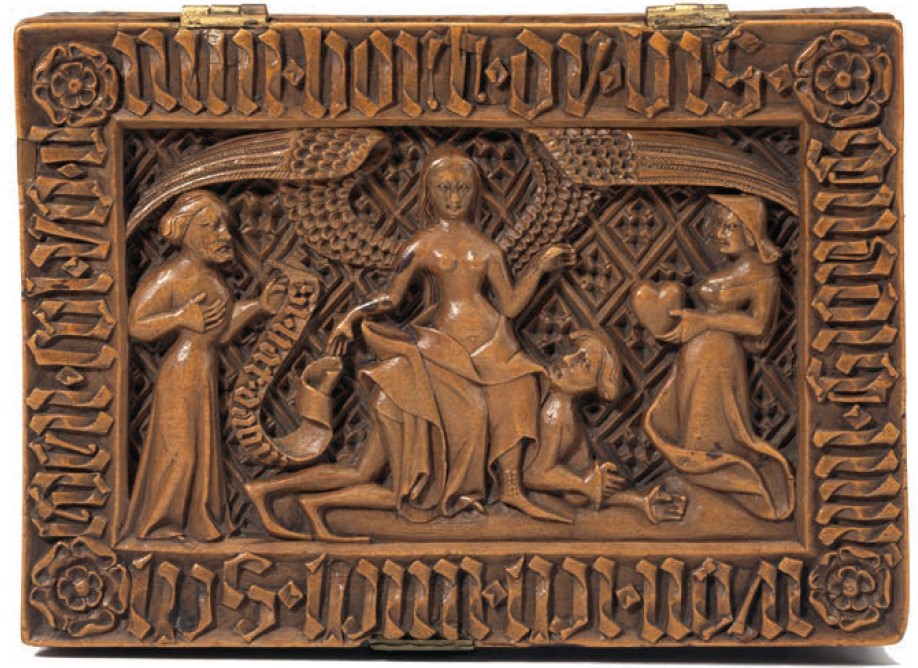
Figure 2: Minnekästchen (cover), wood, end of 14th c. (?), Decorative Arts Museum, State Museums, Berlin.
The Rhenish tapestry below (1400-1425) shows a young woman tying both an old man and a young man to the fence that encloses the court of Frau Minne (see highlighted detail). Alison G. Stewart explains the scene as follows; “This tapestry illustrates the already well-known concept of Love as an enslaver of men of all ages. In particular, it points to the idea that women have the power to reduce interested men to slaves or fools, an idea seen as early as the thirteenth and fourteenth centuries in depictions on Minnekästchen (small ornamental boxes which served as love tokens), on capitals, and in frescoes of Aristotle and Phyllis or Samson and Delilah.” 3
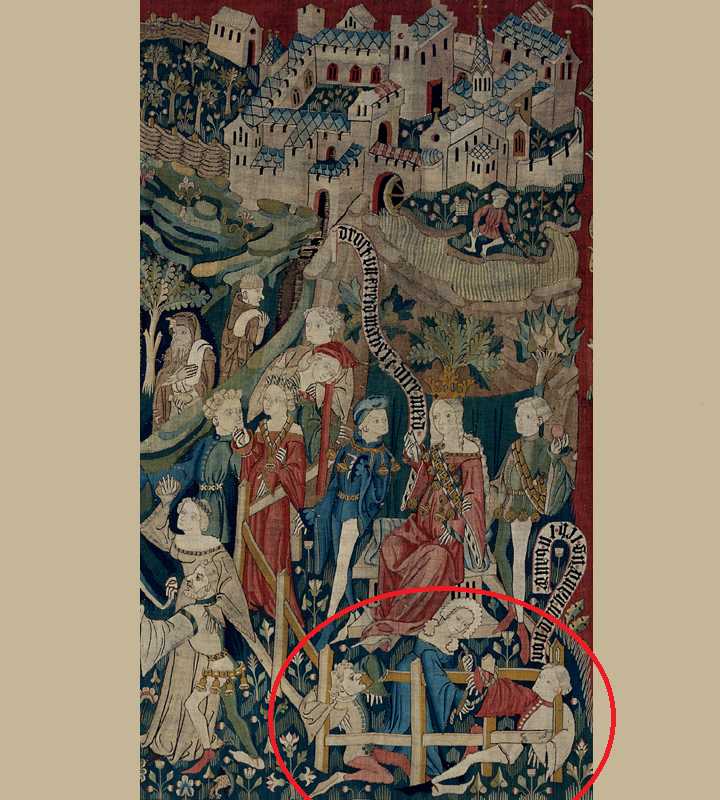
Figure 3: Detail from Courtly Love Games (Spieleteppich), tapestry, circa 1400. Germanisches Nationalmuseum, Nuremberg.
According to Johan Winkelman of the University of Amsterdam, Frau Minne is identified (see figure 4) with a crowned vulva carried aloft by servile, erect penises, thus depicting Minne by her most extreme elemental power.4
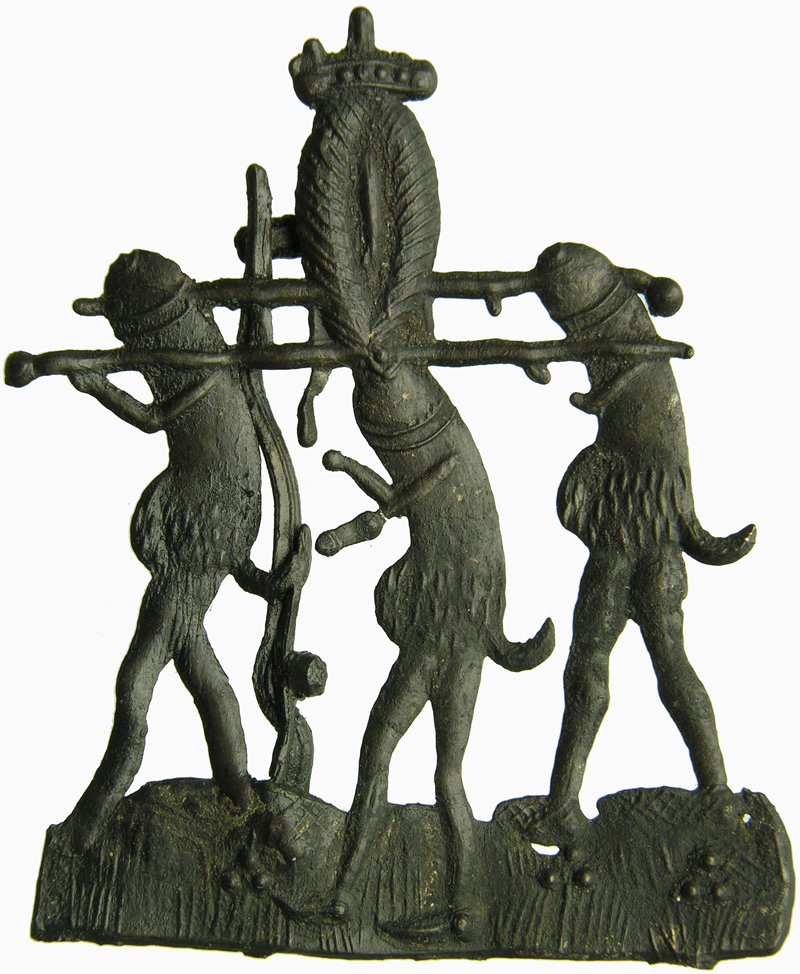
Figure 4: Badge displaying three phalli bearing a crowned vulva in a procession, 1375-1450, found in Brugge (Van Beuningen family collection, inventory number 652)
As mentioned in a previous essay, romantic love began as a code of conduct among the aristocratic classes of the middle ages. However, the trend made its way by degrees eventually to the middle classes, and finally to the lower classes, and ultimately broke class distinctions altogether in the sense that all Western peoples became inheritors of the customs of romantic love regardless of their social station. This breaking of class barriers is marvellously rendered in the painting below by Hans Koberstein (figure 5), who portrays Frau Minne leading a helpless throng of individuals consisting of royalty and pauper, young and old, who are equally held under her sway.
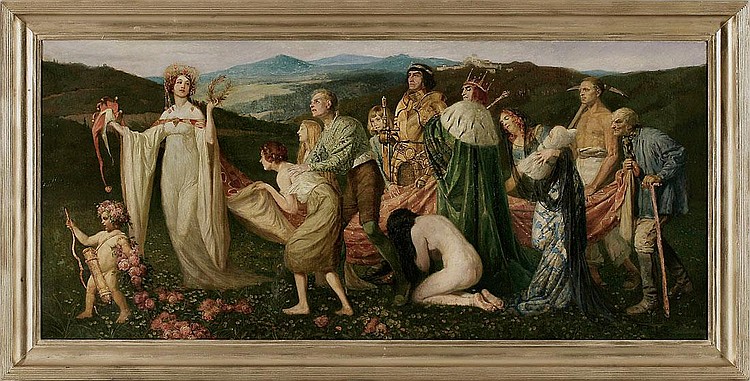
Figure 5: Frau Minne smashes all class barriers, making rich and poor alike suffer from love sickness (Painting by Hans Koberstein, Germany, 1864-1945)
A 15th century depiction “The Power of Frau Minne” (figure 6, below) captures the pain and pathology so widely known to be part of the romantic love experience. The pathology associated with romantic love is so disturbing, in fact, that clinical psychologist Dr. Frank Tallis has written a book detailing the sickness associated with it based on his extensive clinical experience:
Obsessive thoughts, erratic mood swings, insomnia, loss of appetite, recurrent and persistent images and impulses, superstitious or ritualistic compulsions, delusion, the inability to concentrate—exhibiting just five or six of these symptoms is enough to merit a diagnosis of a major depressive episode. Yet we all subconsciously welcome these symptoms when we allow ourselves to fall in love. In Love Sick, Dr. Frank Tallis, a leading authority on obsessive disorders, considers our experiences and expressions of love, and why the combinations of pleasure and pain, ecstasy and despair, rapture and grief have come to characterize what we mean when we speak of falling in love. Tallis examines why the agony associated with romantic love continues to be such a popular subject for poets, philosophers, songwriters, and scientists, and questions just how healthy our attitudes are and whether there may in fact be more sane, less tortured ways to love. A highly informative exploration of how, throughout time, principally in the West, the symptoms of mental illness have been used to describe the state of being in love, this book offers an eloquent, thought-provoking, and endlessly illuminating look at one of the most important aspects of human behavior.5

Figure 6: “The Power of Minne,” – an allegorical depiction of women’s power over men’s hearts (Broadsheet woodcut, 15th century by Master Casper von Regensburg, Berlin, SMB, Kupferstichkabinett)
References:
[1] Frau Minne hat sich gut gehalten, 2009
[2] Naomi Reed Kline The Proverbial Role of Frau Minne: ‘Liebe macht Blind’ – Or Does It? in The Profane Arts: Norms and Transgression, Brepols (2016)
[3] Alison G. Stewart, Unequal Lovers: A Study of Unequal Couples in Northern Art, (1978)
[4] The world upside down. Secular badges and the iconography of the Late Medieval Period, in Journal of Archaeology in the Low Countries 1-2 (November 2009) “Malcolm Jones has pointed out that the crowned vulva on this badge should be interpreted as a persiflage on Mary (Jones 2000, 100-101), whilst Johan Winkelman, Emeritus Professor of Historical German Literature at the University of Amsterdam, identified the vulva as an extreme depiction of Vrouw Minne (i.e. the Middle Dutch equivalent of Venus, a symbol of lust) (Winkelman 2002a, 231). According to the attributes with which she is associated, Vrouw Minne, portrayed as a vulva, is the counterpart symbol of Mary, just like Eve in the above-mentioned miniature from the Book of Hours of Catharina van Kleef.”
[5] Love Sick: Love as a Mental Illness, by Frank Tallis – overview on Goodreads
See also: Romantic love and the medieval birth of the heart emoji
Elizabeth Hobson on ‘proto-feminism’
The following is an excerpt from Elizabeth Hobson’s latest article in PoliQuads Magazine.

Feminists Do Not Get To Define Feminism
By Elizabeth Hobson
Proto-feminism arose in the late Middle Ages. Queen consort of France and England, Eleanor of Acquitaine spearheaded a movement within her court to subvert the chivalric code (which had traditionally governed relations between knights and lords) to regulate the behaviour of men towards women. These women initiated a system of romantic feudalism wherein noble men were under irresistible pressure to identify a lady as midons (my lord) and to submit to her will and delicately accept any scorn that her midons saw fit to extend to him. Eleanor established “Courts of Love” in which she and her noble women would administer “justice” in romantic disputes. Not only may many men in particular recognise this state of gender relations, but the modus operandi that Eleanor and company used to achieve their supremacy is entirely familiar: generalizations about all men based on the poor behaviour of a minority, asserting that women need protection from men’s violations, and a narrative of women’s moral superiority justifying their dictatorship. Within 200 years, Eleanors’ ideas had spread and saturated throughout Europe and throughout the class system….. [continued]
*The rest of this article exploring the various waves of feminism can be read in PoliQuads Magazine
[Book] Chivalry: A Gynocentric Tradition
The following is from the introduction to my new co-authored book (with Paul Elam) of collected writings on chivalry. The book includes updated versions of previously published essays, and two excellent contributions by Paul Elam including a newly transcribed article Death By Chivalry: Portland Edition. You can purchase the eBook here, and the paperback here, or simply click on the cover picture below. – PW.
FROM THE INTRODUCTION
The importance of chivalry is taught to little girls and boys from the start, outlining for them the various rules of male obligation that will guide sexual relations throughout their lifetimes; i.e., males are here to protect and provide.
The victories of legendary cinematic heroes whose brave deeds are rounded with applause and happily-ever-afters appears to seal the fate of chivalry as the future path of every man.
Those few who do pause to question chivalry’s values however – its rote expectation of male sacrifice, possibility of danger or injury, impacts on mental health, potential for exploitation and abuse, or the question of valid compensations for ongoing sacrifices – may conclude that it serves as a poor life map, or worse that it amounts to a malignant and toxic form of masculinity.
This book examines the realities of chivalry beyond the usual platitudes and cliches to see what’s really at stake for men in the present zeitgeist. The essays, written by men’s advocates Peter Wright and Paul Elam, survey the roots of the chivalric tradition and examine real life examples of chivalry in action.
Chapters include:
1. The Birth Of Chivalric Love
2. A Bastardized Chivalry
3. What Ever Happened To Chivalry?
4. Sporting Tournaments: ‘It Will Make A Man Out Of You’
5. Intervening for women
6. Chivalry: A Learned Deathwish
7. Death By Chivalry: Portland Edition
8. Aggrieved Entitlement: Women’s Reaction to Temporary Loss Of Chivalry
9. Can A Woman Be Chivalrous?
